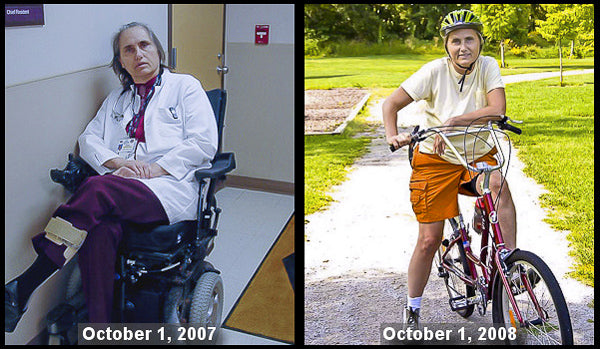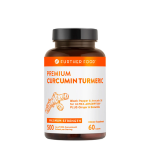From Wheelchair to Biking: Dr. Wahl’s Miracle Recovery from Autoimmune Disease

After Dr. Terry Wahls received a daunting diagnosis of debilitating, progressive Multiple Sclerosis, she made it her mission to modify her lifestyle to change the course of her disease. For those traditionalists who believe it is impossible to reverse secondary progressive MS, it might be time to think again. After extensive research and careful customization of a Paleo regime, Dr. Wahls developed a miracle cure for her MS--one that dismissed medicine and embraced diet and lifestyle. Here’s her story.
I am a medical doctor, and also a professor of medicine. For many years in my practice, I focused on treating disease, not on creating health, because that is what I was taught to do in school and in my training. I was certainly not a “physician of the future.” (That's the term Thomas Edison used to describe the doctor who "will give no medication, but will interest his patients in the care of the human frame, diet, and in the cause and prevention of disease.”) But after my own battle with multiple sclerosis, and the way in which my adoption of a nutrient-rich Paleo diet helped reverse my symptoms and regain strength, I now make it my goal to be a physician of the future. Here’s my story.
A Daunting Diagnosis
In 2000, I was diagnosed with multiple sclerosis, an autoimmune disease that damages the brain and spinal cord, and is the most common cause of early disability in the US. I was told that MS was likely due to a prior infection and unknown environmental factors. No one asked me about or mentioned lifestyle in the management of this disease, but they did talk to me about a slew of powerful medications. I was told it was important for me to take one of the A-B-C drugs (Avonex, Betaseron, or Copaxone). These disease-modifying drugs would decrease the likelihood of an acute MS attack or relapse by about a third.
But the A-B-C drugs presented a grim future, with a 4-digit monthly price tag and a daunting list of side effects. So what was I to do?
I was terrified. How would I support my family, including my wife Jackie and my two kids? I went to the best MS center I could find: the Cleveland Clinic. I saw the best doctors, received the best care possible in the opinion of conventional medicine, and took those latest, greatest drugs.
But amidst my greatest efforts to utilize modern medicine to treat my condition, I continued to gradually deteriorate. It was becoming increasingly obvious to me and to those around me. As the years rolled by, I had an increasingly difficult time with fatigue and endurance. Having always been an active, athletic woman, giving up jogging, hiking, and playing sports with my kids was one of the most difficult challenges I had to face. I watched from the sidelines as the family played without me. I knew I needed to makes some changes.
Could Diet Thwart My Deterioration? Discovering Paleo
In 2002, I discovered the The Paleo Diet, by Loren Cordain, Ph.D., who advocated for a caveman-style diet as a treatment for autoimmune diseases like MS. Traditional Paleo diets such as the regimen I adopted incorporate meat, fish, vegetables and fruit, and eliminate dairy, grains, legumes and processed food. This transition was dramatic for me, as I had been a vegetarian for years and years. Gradually, I reintroduced meat into my diet and gave up the grains and legumes that had been a major part of my diet for almost 10 years. Although with these adjustments to my diet my decline slowed, nevertheless, it continued. At this point, I knew the Paleo diet was not the sole solution.
The Plot Thickens...
I continued to deteriorate, despite my dietary changes. In 2003, three years after my diagnosis, I became dependent on a wheelchair. At this point, my MS was classified as “secondary progressive,” meaning that the disease was steadily progressing with no periods of improvement. Even despite my top notch medical care, all of the specialists out there made it clear to me that with progressive disease, such as mine, I would continue to decline. It was just a fact. No one with secondary progressive MS regains functions that have been lost. I kept getting weaker, even though I was receiving widely used treatments for MS such as chemotherapy and immune-suppressing medications, including powerful medications like CellCept and Tysabri.
At this point, I refused to give up. I went on a mission to find out why my body was failing-- and what I could do about it. I started by using my medical education and began to pore over the research on MS, Parkinson’s and Huntington’s to see what I could learn.
On the Road to Discovery
In people with MS, immune cells damage the myelin sheath, protein and fatty substances that surround nerve cells in the brain and spinal cord. This damage results in slower nerve signals, which lead to muscle weakness, a lack of balance and muscle coordination, bladder or bowel spasms, blurred vision and other unpleasant, degenerative symptoms. Medications, such as those that I was on, can reduce symptoms, but they don’t accelerate nerve signals.
In my heavy research, I began to notice a link between most of these degenerative neurological diseases: dysfunctional mitochondria (the units within cells that supply the energy that’s needed for nerve activity and proper function). After thoroughly reviewing the research, I decided to put myself on a diet that increases the efficiency of the mitochondria. Although the effect of diet on MS was unproven, I firmly believed that this was my best hope for fighting MS.
Supplements to Optimize Mitochondrial Function?
In all of these diseases, the mitochondria don’t work very well, which causes the early death of brain cells and shrinking brains. But what could I do with this information? How could I use it to help me? With more searching, I identified studies on mouse brains protected by fish oil, creatine, and coenzyme Q. At my wit’s end and poised to try anything, I translated those mouse-sized doses to human-sized ones and began my first round of self-experimentation. The rapidity of my decline slowed again, but, alas, continued. Diet was not enough. Supplements alone were not enough either.
Two Life Changing Realizations
In 2007, my health was still declining. I was so tired and my brain so foggy that I could no longer sit in a real chair. Instead, I needed a zero gravity bed or chair. I thought I’d have to leave my job and apply for disability. Yet my quest for information was relentless--I wouldn’t give up. In my continuous research, I began to look into neuromuscular electrical stimulation (e-stim) which is often used on people with muscle paralysis. This could potentially work for me!
After discovering the benefits of experimental electrical stimulation on me (which helped me to resume exercise), I then researched the extensive list of vitamins and supplements my brain and cells and mitochondria required for optimal function. I decided to modify my diet once again to include an optimal amount of these special nutrients. I reasoned that if these added nutrients could make such an impact on me in supplement form, I could and should be getting them from real food rather than from pills. Wouldn’t they be even more potent, even more recognizable to my body, when they were more appropriately "packaged" by nature?
Utilizing my research, I was able to create a diet plan customized specifically for my brain cells and my mitochondria: greens, sulfur-rich vegetables, deeply colored vegetables and berries, grass-fed meat, wild fish, organ meat, and seaweed. I had begun to establish the Wahls Paleo diet, a combination of a Paleolithic-style diet and additional foods and supplements customized to deliver the nutrients functional medicine recommends.
And then the magic happened. And it can happen for you too!
I continued electrical stimulation, revamped my diet, and incorporated deep meditation into my life. The results were astounding. Within weeks, these diet and lifestyle changes helped me to rewrite my future.
It was just like magic. The following month after beginning this custom diet, my energy levels skyrocketed, and the brain fog had disappeared into thin air. Two months later, I was walking again, using a cane. Six months later, I rode my bike for the first time in nearly six years. At 9 months, I completed an 18-mile bike ride with my family. My world had completely changed. I had singlehandedly managed to reverse secondary progressive MS. I was making history, literally.
And yes, in case you were wondering, the Wahls Paleo diet can most definitely be effective for other people with other types of autoimmune problems. At the cellular level, and in many other ways, all autoimmune diseases are very similar in nature, and what helps reverse chronic cellular dysfunction can improve health no matter the disease state. The Wahls Protocol does not treat symptoms. It treats causes.
Now I know that diet and lifestyle can be utterly transformative. By eating a deeply nutrient-dense diet, giving our cells what they need to heal and thrive, we can all become stronger and healthier beings. Although I wasn’t a bonafide physician of the future at the beginning of my journey with MS, I am most certainly becoming one now.
Learn how you can incorporate Dr. Wahl’s protocol in your own life by reading The Wahls Protocol: How I beat progressive MS.
Want more? You might also like:
When “Going Paleo” Didn’t Heal My Lyme Disease and Hypothyroid, I Tried the Wahls Protocol. Here’s What Happened.
After A Lifetime Struggle...How I Finally Beat MS





















